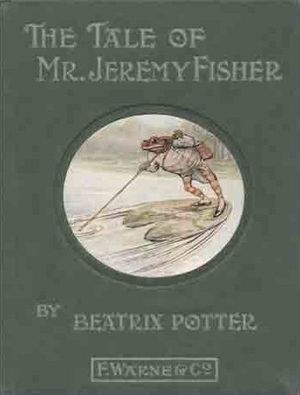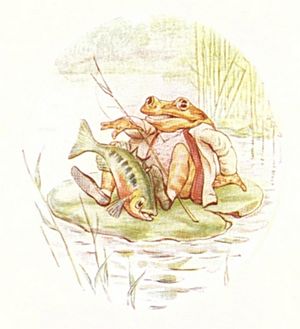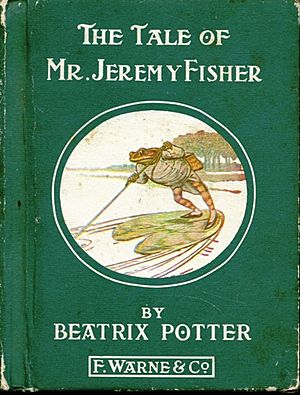The Tale of Mr. Jeremy Fisher facts for kids

First edition cover
|
|
| Author | Beatrix Potter |
|---|---|
| Illustrator | Beatrix Potter |
| Country | England |
| Language | English |
| Genre | Children's literature |
| Publisher | Frederick Warne & Co. |
|
Publication date
|
July 1906 |
| Media type | Print (Hardcover) |
| Preceded by | The Tale of the Pie and the Patty-Pan |
| Followed by | The Story of a Fierce Bad Rabbit |
The Tale of Mr. Jeremy Fisher is a fun children's book written and illustrated by Beatrix Potter. It was first published in July 1906. The idea for the story came from a letter Beatrix Potter wrote to a child in 1893. She later changed the story to be set in the beautiful Lake District in England, a place she loved very much. The book also shows her admiration for another children's artist, Randolph Caldecott.
The main character is Jeremy Fisher, a frog who lives in a "slippy-sloppy" house by a pond. One rainy day, he decides to go fishing for minnows. He hopes to catch enough fish to invite his friends over for dinner. But Jeremy faces many funny challenges and even a scary moment with a big trout! After his adventure, he decides fishing isn't for him and heads home.
Beatrix Potter's story reminds us of the peaceful summers her father and his friends spent fishing in Scotland. After the book came out, a young fan asked if Jeremy would ever get married. Beatrix Potter wrote several tiny letters, pretending they were from Jeremy and his friends, to answer this question. Even after Potter passed away in 1943, her characters, like Jeremy, became popular toys, figurines, and other items.
Contents
Jeremy's Fishing Adventure
Jeremy Fisher is a frog who lives in a damp house among the buttercups next to a pond. His home is a bit wet, but Jeremy doesn't mind getting his feet wet. He never gets scolded, and he never catches a cold!
One day, it's raining, and Jeremy decides to go fishing. He plans to invite his friends to dinner if he catches more than five minnows. He puts on his raincoat and shiny boots, grabs his fishing rod and basket, and hops to his lily-pad boat. He paddles to a spot he knows is good for catching minnows.
Jeremy sits on his lily-pad with his legs crossed. He sets up his fishing gear, which includes a cute little red float, a grass stalk for a rod, and a horsehair for a line. An hour goes by, and he doesn't get any bites. He takes a break and eats a butterfly sandwich. A water beetle then pokes his toe, making him pull his legs away. Rats rustling in the reeds make him move to a safer spot.
He drops his line back into the water and immediately feels a tug! But it's not a minnow; it's a small stickleback named Jack Sharp. Jeremy pricks his fingers on Jack's sharp spines, and Jack gets away. A group of small fish swim to the surface and seem to laugh at Jeremy.
Jeremy sucks his sore fingers. Suddenly, a big trout jumps out of the water and grabs him! Jeremy screams, "OW-OW-OW!!!" The trout dives to the bottom but finds Jeremy's raincoat tastes bad. It spits Jeremy out, only swallowing his boots. Jeremy pops back up to the water's surface like a cork. He quickly swims to the edge of the pond. He climbs onto the bank and hops home through the meadow. He lost his fishing gear, but he's sure he will never go fishing again!
At home, Jeremy puts a sticking plaster on his sore fingers. He welcomes his friends: Sir Isaac Newton, a newt, and Alderman Ptolemy Tortoise, a tortoise who loves salad. Isaac wears a fancy black and gold vest, and Ptolemy brings a salad in a string bag. Jeremy has prepared roasted grasshopper with ladybird sauce. The story says this is a "frog treat," but the narrator thinks "it must have been nasty!"
How the Story Came to Be
Beatrix Potter loved frogs when she was young, and they helped inspire Jeremy. Her father, Rupert William Potter, also loved sport fishing. Margaret Lane, who wrote about Beatrix Potter, says that Beatrix grew up hearing her father and his friends tell exciting fishing stories. The scene where Mr. Jeremy Fisher tells his bad luck story to Sir Isaac Newton is very detailed. It shows how well Beatrix Potter observed both animals and older gentlemen.
Beatrix Potter's father not only fished but also collected art by Randolph Caldecott, another famous illustrator. In Jeremy Fisher, Beatrix Potter tried to draw like Caldecott. She felt she didn't quite succeed, but she greatly admired his work.
Linda Lear, who wrote a book about Beatrix Potter, explains that Potter wanted to write a frog story for a long time. She thought it would be fun and allow her to draw nature accurately. The story of a fisherman having a tough day reminded Beatrix of the "fish stories" her father's friends told in Scotland. It also brought back memories of her brother's struggles with fishing. The book's words and pictures work very well together. Nature is shown truthfully, being both peaceful and sometimes wild. The detailed drawings of water plants, a frog with correct feet, a realistic trout, and a scary water-beetle make the book a joy to look at and read.
Tiny Letters from Jeremy and Friends
Around 1907, Beatrix Potter started writing tiny letters to her young fans. She would send them in a miniature mailbag or mailbox. Potter said some of these letters were very funny.
About 1910, she wrote four Jeremy letters to a child named Drew Fayle. Drew thought Jeremy should get married! In one letter, Sir Isaac promises Master Fayle a piece of wedding cake if Jeremy ever marries. In another, Ptolemy writes that Jeremy's parties would be much nicer if a lady was in charge of the table.
Jeremy writes in the third letter: "When I bought my sprigged waistcoat & my maroon tail-coat I had hopes ... but I am alone ... if there were a 'Mrs. Jeremy Fisher' she might object to snails. It is some satisfaction to be able to have as much water & mud in the house as a person likes."
Mrs. Tiggy-winkle, a hedgehog washerwoman from another Potter story, writes to Master Fayle in the fourth letter:
Dear Master Drew,
If you please Sir I am a widow; & I think it very wrong that there is not any Mrs. Fisher, but I would not marry Mr. Jeremy not for worlds, the way he does live in that house all slippy-sloppy; not any lady would stand it, & not a bit of good starching his cravats.
Yr. obedient washerwoman, Tiggy Winkle.
Jeremy Fisher Toys and Collectibles
Characters from Jeremy Fisher have been made into many different items. These include porcelain figurines, soft plush toys, and other collectibles. In 1950, Beswick Pottery made a porcelain figurine of Jeremy. Figurines of Isaac and Ptolemy followed in the 1970s. Many other Jeremy figurines and even a Jeremy mug have been created over the years.
Jeremy was one of the first eight plush toys released by Eden Toys, Inc. in New York in 1973. The next year, a giant 37 inches (94 cm) Jeremy plush was made for store displays. During the Beanie Baby craze, Jeremy was even made into a beanbag toy. Isaac Newton plush toys were also available for a couple of years.
Jeremy Fisher was also one of the first ten character music boxes released by Schmid & Co. in 1977. Music boxes for Ptolemy and Isaac came out in the 1980s. Ceramic Christmas ornaments of Jeremy have also been made by Schmid. Other items include special enamelled boxes by Crummles, wood carvings and figurines by ANRI, and Huntley & Palmer biscuit tins.
Books and Translations
Even today, all 23 of Beatrix Potter's small books are still being printed. You can buy them in complete sets or in one big book. The English versions of the stories are still published by Frederick Warne, even though Penguin Books bought the company in 1983. In 1985, Penguin updated the printing plates, and all 23 books were re-released in 1987 as The Original and Authorized Edition.
Frederick Warne continues to publish Potter's books. A 2002 article in Publishers Weekly celebrated 100 years since The Tale of Peter Rabbit was first published. It said that Beatrix Potter is one of the most popular classic writers. Special anniversary editions of her work were published in 1993 and 2002, with brighter and fresher illustrations.
The Tale of Mr. Jeremy Fisher has been translated into many languages. It was published in French in 1940 as Jérémie Pêche-à-la-Ligne and in Dutch in 1946 as Jeremais de Hengelaar. The Dutch version was republished in 1970, and the book was also published in a special reading alphabet in 1965. In 1984, it was translated into French again. By 1986, Beatrix Potter's books had become a traditional part of childhood in many English-speaking countries and in many other countries where her books have been translated.
Jeremy Fisher on Screen
- A shorter version of the story was part of the 1971 ballet film, The Tales of Beatrix Potter.
- The story was made into a cartoon, along with The Tale of Mrs. Tiggy-Winkle, for an episode of the 1992 BBC television series The World of Peter Rabbit and Friends.
- Mr. Jeremy Fisher appears in the 2012 computer-animated TV series Peter Rabbit on Nickelodeon. Jack Sharp and Alderman Ptolemy Tortoise (who is called Mr. Tolly Tortoise in the show) also appear.
- Mr. Jeremy Fisher is in the 2018 movie Peter Rabbit, which mixes animation and live-action. His voice is done by Domhnall Gleeson.



